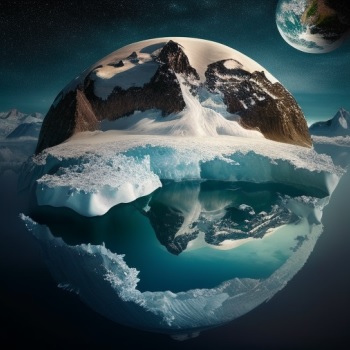There are many mysterious facts in the world that are still not fully understood by scientists and researchers. Some examples include:
This area of the Atlantic Ocean, roughly bounded by Miami, Bermuda, and Puerto Rico, is said to have a high incidence of unexplained disappearances of ships and airplanes.
The Voynich Manuscript: This medieval book, written in an unknown script and cipher, has never been fully deciphered despite numerous attempts.
The Tunguska Event: In 1908, an explosion occurred in a remote region of Siberia, flattening trees over an area of 830 square miles. The cause of the explosion is still unknown and various explanations including meteorite impact and comet fragments have been proposed.
This legendary creature, said to inhabit Loch Ness in Scotland, has been the subject of many sightings and expeditions, but no concrete evidence of its existence has been found.
These ancient structures, built around 2500 BC, continue to fascinate and perplex scientists and researchers. The precision and accuracy of the pyramids’ construction is still not fully understood, and how the ancient Egyptians were able to move and place the massive stone blocks remains a mystery.
These are just a few examples, but there are many other mysterious facts and phenomenon in the world that are yet to be fully understood.
There are many interesting facts in the world, and what one person finds interesting may not be the same as what someone else finds interesting. However, here are a few examples of interesting facts:
The human brain is the most complex structure in the known universe. It contains more connections than there are stars in the Milky Way galaxy.
The Earth is not a perfect sphere, but an oblate spheroid, meaning it is slightly flattened at the poles and bulging at the equator due to its rotation.
The Great Barrier Reef, the world’s largest coral reef system, is visible from space and is the largest living structure on Earth.
The oldest known sample of the smallpox virus was found in the teeth of a 17th-century child buried in Lithuania.
The tallest known organism in the world is a coast redwood tree named Hyperion, which stands at 379.7 feet tall.
Again, these are just a few examples and there are many more interesting facts out there that could be found in different fields such as science, history, culture, etc.
Glaciers store and release large amounts of fresh water, which is essential for human consumption, agriculture, and industry. Many major rivers, such as the Ganges, Indus, and Brahmaputra, are fed by glacial meltwater, providing water for millions of people.
Glaciers act as natural reservoirs, storing water in the form of ice during the winter and releasing it during the summer. This helps to regulate water flow and prevent floods.
Glaciers play a key role in regulating Earth’s climate by reflecting sunlight back into space and influencing ocean currents. They also help to maintain the balance of carbon and other greenhouse gases in the atmosphere.
are major tourist attractions, drawing visitors from all over the world to see their natural beauty and witness the effects of climate change.
Glaciers provide opportunities for various recreational activities such as hiking, skiing, ice climbing and mountaineering.
Glacial meltwater is vital for hydroelectric power generation, irrigation and mining.
However, as the world is facing the global warming and climate change, glaciers are melting at an alarming rate and may have negative impact on human lives such as water scarcity, and more severe floods and droughts. Therefore, it is important to understand the importance of glaciers and take necessary actions to protect them.
There are several ways to protect glaciers, some of which include:
The primary cause of glacier melting is the warming of the Earth’s atmosphere due to human activities, such as burning fossil fuels, deforestation and industrial processes. Reducing emissions by transitioning to renewable energy sources, and implementing policies to decrease emissions such as carbon pricing and emissions standards, can help slow down the warming and hence the melting of glaciers.
Establishing protected areas around glaciers, such as national parks and wilderness areas can help safeguard them from human impacts such as pollution, development, and overuse.
Implementing sustainable tourism practices, such as limiting the number of visitors, providing education, and promoting responsible behavior can help reduce the impact of tourism on glaciers.
Ongoing research and monitoring of glaciers can help scientists better understand the effects of climate change on glaciers and develop effective strategies to protect them.
Involving local communities and indigenous peoples in conservation efforts can help ensure that the protection of glaciers is sustainable in the long term.
Climate change is a global problem and requires international cooperation to address it. International agreements such as the Paris Agreement, as well as actions taken by the United Nations Framework Convention on Climate Change (UNFCCC) can provide a framework for protecting glaciers globally.
It is important to note that protecting glaciers requires a multi-faceted approach and the participation of governments, organizations, and individuals.
There are an estimated 198,000 glaciers in the world. They are found on all continents, with the exception of Australia, and in various mountain ranges such as the Himalayas, Andes, Rocky Mountains, and Alps. The majority of glaciers are located in polar regions, such as Antarctica and Greenland.
It’s worth noting that the number of glaciers is constantly changing due to natural processes such as snowfall and melt, as well as human-induced changes such as climate change. The estimates for glaciers numbers and areas are based on satellite data and aerial photographs and tend to have a margin of error.
Also, it’s important to mention that the number of glaciers is decreasing due to the global warming, and the majority of glaciers are shrinking, losing mass and volume, which is affecting the local and global water resources, sea level rise and natural hazards such as floods and landslides.
There are over 5,000 glaciers in Pakistan, many of which are located in the Karakoram, Hindu Kush, and Himalayan mountain ranges. These glaciers are an important source of water for the country, and they also play a critical role in the local ecosystem. However, due to climate change, many of these glaciers are melting at an accelerated rate, which is causing concern for the long-term water security of Pakistan.
The largest glacier on Earth is the Lambert-Fisher Glacier located in Antarctica. It is about 60 miles wide and over 300 miles long, with a total area of about 8,100 square miles. It is also one of the fastest moving glaciers on the planet, with some sections moving at rates of up to 7 kilometers (4.3 miles) per year. The Lambert-Fisher Glacier drains into the Amery Ice Shelf and is a major contributor to the ice flowing into the ocean.



